Calculating an electrical load boils down to one core task: adding up the total wattage of everything you plan to connect to a single circuit. That means every light, appliance, and outlet. The basic formula is a classic for a reason: Watts = Volts x Amps.
But a straight-up sum is just the starting point. We then have to apply what are known as demand factors. This is where the real-world expertise comes in, helping you build a system that's not just functional, but safe and up to code.
Why Getting the Electrical Load Right is Non-Negotiable
Let's get one thing straight before we dive into the math—this isn't just about crunching numbers. A proper load calculation is the absolute bedrock of a safe and reliable electrical system. Getting it wrong isn't just a minor inconvenience; it can lead to some serious headaches and even dangerous situations.
Think of it like this: your electrical circuit is a bridge, and the load calculation tells you how much traffic it can safely handle. If you underestimate that load, you're overloading the bridge. Best case? You're constantly dealing with tripped breakers. Worst case? The wires overheat inside your walls, creating a very real fire hazard.
On the other hand, if you wildly overestimate, you're just throwing money away. You'll end up paying a premium for a beefier electrical panel and thicker, more expensive wiring that your home or business simply doesn't need. The goal is to find that sweet spot: powerful enough for your needs, but sized correctly for safety and efficiency.
Continuous vs. Non-Continuous Loads
One of the first things an experienced electrician learns to distinguish is the type of load. It’s not just about what's plugged in, but how long it's going to be running.
Non-continuous loads are the "in-and-out" devices. Think toasters, blenders, or a vacuum cleaner. They run for a few minutes and then shut off. For these, you can just use their listed wattage for your calculation.
Continuous loads are the marathon runners. These are things expected to operate for three hours or more at a time. We're talking about commercial lighting systems, water heaters, or an HVAC unit in the middle of summer. Because they run for so long, they generate a lot more heat. To account for this, safety codes require us to calculate their load at 125% of their actual rating. This built-in buffer is crucial; it ensures the circuit can handle that sustained demand without risking an overheat.
The Building Blocks of a Load Calculation
Before you can confidently tackle any calculation, you need to be comfortable with the language. These are the fundamental terms that form the basis of every electrical formula and you'll see them stamped on the nameplate of just about every appliance.
At its core, the total power a system needs to handle is found with a simple formula: Load = Voltage x Current. If you need to figure out the average load over a period, the calculation becomes: Average Electrical Load = (Total Power Consumption) / (Time). You can get a deeper dive into these formulas and how they're used from the experts at Bluetti Power.
To make things easier, here's a quick cheat sheet for the key terms you'll encounter.
Key Electrical Terms at a Glance
Getting a firm handle on these basics is the first real step toward a successful project. When you size your system correctly, you're building something that can safely and efficiently handle modern electrical demands.
Plus, understanding your electrical load is the first step toward reducing it. Once you know where your energy is going, you can find opportunities to be more efficient. For some great ideas on this, check out these smart tips for saving electricity at home.
Figuring Out Your General Lighting and Receptacle Loads
Before you can even think about the big power-hungry appliances, you have to get a handle on the basics. I'm talking about the general lighting and the everyday wall outlets, or receptacles, that are spread throughout a home. These form the baseline electrical demand of the entire structure.
Getting this foundational number right is the first, and arguably most important, step in any residential load calculation. The National Electrical Code (NEC) actually gives us a straightforward, standardized way to do this. Instead of the headache of counting every single light fixture and outlet, the code simplifies things based on the home's square footage. It’s a reliable method that gives us a solid starting point.
The 3 VA Per Square Foot Rule
For any house or apartment, the go-to standard is 3 volt-amperes (VA) per square foot. In the world of residential calculations, you can essentially treat volt-amperes and watts as the same thing, so think of it as 3 watts per square foot.
This number is a catch-all. It covers all the standard 120-volt circuits that run the lights and outlets in places like living rooms, bedrooms, hallways, and family rooms. It cleverly bundles these two common loads into a single, easy-to-calculate figure.
A Quick Tip from the Field: This 3 VA rule doesn't cover everything. You'll need to add separate calculations for the dedicated small appliance circuits in the kitchen, the laundry room, or the garage. We'll stack those on top of this general load later on.
Let's put this into practice with a real-world example.
Say we're working on a typical single-family home that measures out to 2,000 square feet of livable space.
To get our general lighting and receptacle load, the math is simple. We just multiply that square footage by the NEC's 3 VA rule.
- Calculation: 2,000 sq. ft. x 3 VA/sq. ft. = 6,000 VA
And there it is. That 6,000 VA is the first major number we'll put on our load calculation worksheet. It's the foundational power demand before we even start thinking about the electric range or the central air conditioner.
This image here gives a nice visual of how we start with this general load and then begin adding the specific wattages of other major appliances.

As you can see, once this base is established, you build a complete picture by itemizing the power requirements of individual appliances.
Why This Method is So Reliable
This standardized approach is a lifesaver. It prevents the kind of wild miscalculations that happen when you try to guess how many gadgets a homeowner will plug in or what kind of light fixtures they’ll eventually install. Think about it—when you're wiring a new house, you have no idea what lamps or electronics the future owners will bring with them. The 3 VA rule gives us a solid, code-compliant estimate that ensures the electrical system has plenty of juice.
Of course, some areas need special attention. For instance, when it comes to a kitchen, you might want to dig deeper into choosing the perfect kitchen lighting to get a better sense of the higher wattages you might be dealing with. This helps make sure those specialized areas are also well-powered.
Getting this first calculation right is absolutely critical. It’s the foundation that all other loads—from the water heater to the EV charger—will be built upon. Nailing this number ensures the final service size you calculate will be safe, accurate, and up to code.
Tackling Major Appliances and Fixed-In-Place Equipment
Alright, with the general lighting and receptacle load squared away, we need to turn our attention to the real power hogs in any home. I'm talking about the big stuff: electric ranges, water heaters, clothes dryers, and your HVAC system. These aren't like the small gadgets we've already accounted for; they draw a serious amount of power and demand their own specific calculations.

Honestly, this is where many load calculations go wrong. Forgetting or underestimating even one of these major appliances is a classic recipe for an undersized service panel. You'll know it when the main breaker keeps tripping every time you try to cook a big holiday meal with the heat running.
Hunt Down the Nameplate Rating
Every major piece of equipment has what’s called a nameplate rating. It's usually a small metal plate or sticker, often tucked away on the back or bottom of the unit. This little tag is your go-to source, spelling out all the critical electrical info you need.
You're looking for the power consumption, which will be listed in either watts (W) or volt-amperes (VA). For most residential jobs, you can treat watts and VA as being the same. If the nameplate only gives you volts (V) and amps (A), you’ll have to do a quick bit of math:
Watts = Volts × Amps
So, if you find a water heater rated at 240V and 18.75A, its load is 4,500 watts (240 × 18.75). You’ll take that number and add it directly to your calculation worksheet. Simple as that.
Common Appliance Loads to Expect
While you should always, always check the nameplate for the precise number, it helps to know the typical values you'll encounter. It gives you a good feel for the scale you're working with.
- Electric Clothes Dryer: Plan for at least 5,000 watts.
- Electric Range/Oven: These are hefty, often falling between 8,000 watts and 12,000 watts or more.
- Electric Water Heater: A common figure is around 4,500 watts.
- HVAC System: This is a big variable. The load depends heavily on the unit's size and efficiency, but it’s always a major contributor.
Pro Tip: Remember this crucial rule from the National Electrical Code (NEC). Any appliance that's a continuous load—meaning it could run for three hours or more, like a water heater or HVAC unit—needs to be calculated at 125% of its nameplate rating. This buffer is a safety measure to ensure the circuit can handle the prolonged heat without posing a risk.
An Example in Action
Let's get back to our sample 2,000 sq. ft. house. We've already established a general lighting and receptacle load of 6,000 VA. Now it's time to add the fixed appliances, using their nameplate ratings:
- Electric Range: 12,000 VA
- Electric Water Heater: 4,500 VA
- Electric Dryer: 5,000 VA
- Dishwasher: 1,200 VA
- Garbage Disposal: 900 VA
Adding just the appliance loads gives us a subtotal of 23,600 VA.
When we combine that with our earlier general load, our running total climbs to 29,600 VA. This process of stacking the individual heavy loads on top of your baseline is exactly how you build an accurate picture of the home's total electrical demand.
Getting Realistic with Demand Factors
After you've painstakingly added up every light, outlet, and major appliance, you're probably looking at a pretty big number. That figure is the total connected load. It’s what you’d get if every single thing in the house switched on at full blast at the exact same time.
But let’s be real, when does that ever actually happen in a home?
Life isn't a theoretical maximum. You might have the microwave running while the TV is on, but it’s highly unlikely you’re also using the toaster, clothes dryer, and central air conditioner all at once. This is where a professional load calculation gets smart. We apply something called demand factors to bring that huge number back down to earth.
So, What Are Demand Factors, Really?
Think of demand factors as multipliers, spelled out for us in the National Electrical Code (NEC), that help us trim down the total connected load. The result is a much more practical number called the demand load.
This isn't about cutting corners or taking chances. It's a code-approved, standard practice that prevents us from installing a massive, overly expensive electrical panel that's way more than the home will ever need. The NEC knows it's improbable for everything to run simultaneously, so it builds in these allowances. For example, it provides specific de-rating rules for kitchen appliances and electric ranges because they rarely all run at full tilt together.
Applying Demand Factors in the Real World
The most common demand factor we use is for the general lighting and receptacle load. The NEC gives us a simple, two-step method for this, and it’s one of the first things that separates a quick tally from a truly professional assessment.
Here's the rule of thumb: take the first chunk of the load at full value, and then apply a hefty discount to the rest.
Specifically, the NEC directs us to apply a 100% demand factor to the first 10 kW of this general load. For anything over that 10 kW threshold, we only have to account for 40% of it. This strategy is key to sizing panels and services economically without ever compromising on safety. You can dive deeper into how the pros handle this by checking out these professional load calculation guidelines.
Let's walk through a quick example to make it crystal clear.
Let’s say a house has a total connected general load of 30,000 watts (or 30 kW) from its lighting, outlets, and some fixed appliances. Instead of provisioning for the full 30 kW, we apply the demand factor like this:
- First 10 kW: 10,000 W x 100% = 10,000 W
- Remaining Load: The rest is 20,000 W (30,000 - 10,000). We take that at 40%. So, 20,000 W x 40% = 8,000 W
Now, we just add those two numbers together. The final demand load is 18,000 W (or 18 kW). That’s a much more realistic—and affordable—number to work with when we size the final electrical service.
Sizing Your Electrical Service Correctly

Alright, you've done the legwork. You’ve tallied up the general lighting, factored in all the big-ticket appliances, and applied the necessary demand factors. Now comes the moment it all leads to: sizing your home's main electrical service. This is the whole point of a load calculation.
This final step translates all that number-crunching into a real-world decision. Will it be a 100A, 150A, or 200A service? Getting this right is crucial. It ensures your system can handle the daily demands safely, won't trip breakers when you need power the most, and will pass inspection without a hitch.
Converting Total Load to Amperage
So, how do we get from our total load in volt-amperes (VA) to the amperage that determines the main breaker size? We use a simple, familiar formula, but this time, it's applied to our final, demand-adjusted total.
Amps = Total Demand VA / Voltage
For nearly all modern residential properties in North America, the standard service voltage is 240 volts. That’s the number you'll use to divide your final VA total.
Let’s stick with our running example. If your total calculated load, after all demand factors, is 28,800 VA, the math is pretty straightforward:
28,800 VA / 240 Volts = 120 Amps
This result tells us the absolute minimum service capacity needed to safely power this home is 120 amps. Accuracy here isn't just about meeting code; it has real financial implications. A 1984 study in the UK found that just a 1% increase in load forecasting error resulted in an extra £10 million in annual operating costs for a utility. While that's on a massive scale, the principle of accuracy holds true for any project.
Choosing the Standard Service Size
Here's a key piece of practical knowledge: you can't just walk into a supply store and ask for a 120A main breaker. Electrical services come in standard sizes. You always have to round up to the next available standard size.
Based on our calculation of 120 Amps, the next standard service size up is 150 Amps. This is the correct and safe choice for this home. It provides a comfortable buffer and leaves a little room for future upgrades without going overboard.
Here are the most common residential service sizes you'll encounter:
- 100 Amps: Often found in older or smaller homes.
- 150 Amps: A common size for mid-sized homes with standard appliances.
- 200 Amps: The new standard for most modern homes, especially with electric heat or an EV charger.
- 400 Amps: Reserved for very large, high-demand custom homes.
Once you have a firm grasp of your home's electrical needs, you can also start exploring how renewable energy might fit in. A good load calculation is the first step in using a solar panel calculator to accurately estimate the right system size for your home. After all, you can't size a solar installation correctly if you don't know your demand.
Common Questions on Electrical Load Calculations
https://www.youtube.com/embed/IebflvdLVvM
Even after you’ve walked through the formulas and examples, it's completely normal to have some questions floating around. Electrical load calculation is a dense topic, and getting the details right is what separates a safe, functional system from a hazardous one. Let's tackle some of the most common questions I hear from homeowners and apprentices alike.
Connected Load vs. Demand Load
One of the biggest hang-ups for people new to this is the distinction between connected load and demand load. They sound similar, but they represent two very different things.
Think of the connected load as the absolute, theoretical maximum. It’s what you get if you add up the wattage of every single light, outlet, and appliance in the building. It assumes a world where you have the dishwasher, oven, all the lights, the TV, and your power tools running all at once. It’s a useful number for inventory, but it’s not realistic for sizing a service.
Demand load is where the real-world expertise comes in. This is the figure we actually use for design. It’s the connected load adjusted by applying demand factors from the National Electrical Code (NEC). These factors account for the reality that a family isn't going to run every single electrical device they own simultaneously. The demand load gives us a practical, safe number to size panels and service conductors without overspending on equipment you’ll never fully use.
Can You Calculate Your Own Electrical Load?
Absolutely. In fact, I encourage homeowners to do a rough calculation for their own knowledge. It’s a fantastic way to get a real handle on your home’s power consumption, especially if you're thinking about a big addition.
Planning on getting an EV charger, a hot tub, or maybe a new electric range? Running the numbers yourself will give you a ballpark idea of whether your current panel can handle it.
However, and this is the important part, your calculation is for your eyes only.
For any actual permits or installation work, the final, official load calculation must be performed by a licensed and insured electrician. This is a non-negotiable step for safety, code compliance, and passing any required inspections.
What Happens If the Calculation Is Wrong?
Getting the load calculation wrong can cause some serious headaches, ranging from inconvenient to downright dangerous.
If you underestimate the load, you're setting yourself up for failure. The most immediate sign will be breakers that trip constantly. But the bigger, hidden danger is that undersized wiring can overheat under the strain, which is a significant fire hazard.
On the flip side, if you overestimate the load, the danger isn't to your safety but to your bank account. You'll end up paying for a much larger and more expensive electrical panel, service entrance cable, and breakers than your home actually needs. Precision is key—it ensures safety while keeping the project on budget.
How to Find Appliance Wattage
So, where do you get the numbers for your calculation? Most appliances make this pretty easy. You just need to find the manufacturer's nameplate.
This is usually a small sticker or metal plate found on the back, bottom, or sometimes inside the door of an appliance. It’s the device’s official spec sheet, listing critical info like voltage, amperage, and often, the wattage.
- On a refrigerator: Check the back or inside the main compartment.
- On a dishwasher: Look along the edge of the door or on the tub frame.
- On a furnace or air handler: It's typically on the side of the main cabinet.
If the nameplate only gives you volts (V) and amps (A), don’t worry. You can find the wattage with a quick calculation using the basic power formula:
Watts = Volts × Amps
Just multiply the two, and you've got the number you need to plug into your load calculation.
Are you tired of chasing down technicians for messy, incomplete job notes? Nora by ResQ transforms how your field crew logs work. Technicians can send voice notes, texts, or photos directly through WhatsApp, and Nora's AI instantly organizes them into clean, detailed job logs. Stop wasting time deciphering handwriting and get the accurate data you need for faster invoicing and better communication. See how Nora can streamline your operations.



